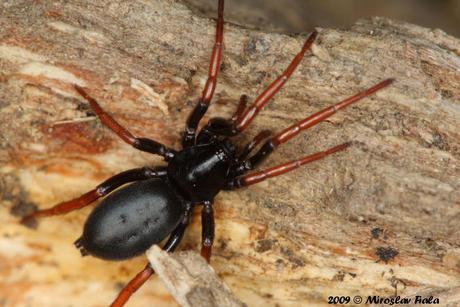Taxology:
Regnum: Animalia
Phylum: Arthropoda
Classis: Arachnida
Ordo: Araneae
Subordo: Araneomorphae
Familia: Gnaphosidae
Genus: Zelotes
Species: Trachyzelotes pedestris
Occurence:
It is current all over in Europe and in Syria. It lives under stones, between the dead fallen leaves, in the soggy fields, int he willow forests. It prefers the soggy places.
Morphology:
It’s got two major body sections: the forebody- (prosoma) and the supplementary (opisthosoma). The segments can not be seen on the body sections. On the forebody before the orifice the limb origin articulated for two pieces chelicerae, from the chelicerae opens the tube of the poison-gland into the outside. Its chelicerae’s way is normal to the axis of the body. The second pair of the limbs is alterates too, it is called pedipalp. The first function of the pedipalp is the sensation, but at the males it became for a difficult conformational secondary reproductive organ. The forebody’s got 4 pairs of legs. The colour of the legs of the Trechyzelotes Pedestris is orange. Their legs are strong, podgy, opulently bristlesed, and it has got quilles. we can find the 8 eyes on the forebody. These are located int he two lines. The eyes from the middle of the front eye-line are black, the other eyes are black.
The spinnerets are at the back of the opisthosoma. The outlet of the silk glands are on the top of the spinnerets. Its front silk glads are pipe-shaped, and they are separated from eachother. Its abdomen is cylindrical and a bit flat. The animal is black except its legs. The male is 4,5−6 mm long, and the female is 6−9 mm long.
Nourishment:
It doen’t make web, it looks for food at night on the ground. It ingests insects.
Habitat:
We can find it under the stones, between the dead fallen leaves int he daytime. It hunts at night. We can meet the adult animals from May to July.
Reproduction:
The male dances to the female before the mating, to get closer to her. The male makes a sachet, and he put his sperm in it. The male takes his pedipalp in the sachet to absorb the sperm. At the mating the male puts his pedpalp into the female’s reproductive system. The female stores the sperm in a ventricle, and she uses it at the egg laying. The female put the eggs in a silk sachet, we call it coccon. The grub differing just a bit from the adult spider.
It is not endangered.
Dr. Móczár László: Állathatározó II. Tankönyvkiadó, Budapest, 1984
Dr. Dudich Endre és Dr. Loksa Imre: Állatrendszertan, Tankönyvkiadó, Budapest, 1981
Dr. Loksa Imre: Magyarország állatvilága, 18. kötet, Arachnoidea., 2. Füzet, Akadémiai Kiadó, 1969
Rod Preston-Mafham: Pókok és skorpiók, Holló és Társa Kft., 1998
